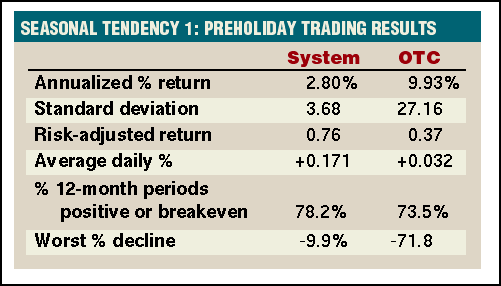CYCLES
Season's Greetings
The Stock Market, The Calendar, And You
by Jay Kaeppel
What's more important -- what you buy or when you buy it?
Seasonality in the market has long been a well-documented phenomenon. A detailed look at the stock market will lead you to conclude that there are certain times when it is more advantageous to be in the stock market than other times. Seasonality offers a viable approach to investing and trading, and in this article I want to focus on this aspect. I will illustrate how combining four basic seasonal tendencies can maximize returns.
One advantage of employing a seasonal system is that it will leave you in cash and earning interest risk-free much of the time, rather than leaving you fully exposed in the stock market. In addition, you will only be invested on those days with a historical tendency to show advances.
Most research on seasonality uses the Standard & Poor's 500 as a benchmark, yet my research indicates it is advantageous to look at the Nasdaq Composite (OTC) because the OTC tends to make more pronounced movements. Thus, utilizing the OTC as a benchmark would offer you greater profit potential if you were to use a seasonal timing system.

FIGURE 2: RESULTS SUMMARY. Not exactly the best returns, but you're not in the market much. Average daily return for the two preholiday trading days was +0.171%. In comparison, the average daily return for the OTC on all other trading days was only +0.032%.
THE FOUR KEY SEASONAL TENDENCIES
There are distinct seasonal tendencies that can be defined and utilized:
1. The two days before exchange holidays
Buy at the close on the third day before an exchange holiday. Sell at the
close two days later. For example, if Christmas were on a Wednesday, you
would buy at the close on the Friday prior and then sell at the close on
Tuesday (December 24). The holidays included in this test are New Year's
Day, Presidents' Day, Easter, Memorial Day, July 4, Labor Day, Thanksgiving,
and Christmas.
2. The last trading day of the month and the first four days of
the next month
Buy at the close on the next to last trading day of each month, and sell
at the close on the fourth trading day of the next month. Norman Fosback
popularized this monthly five-day technique in his book Stock Market Logic.
This seasonal tendency has steadily continued to make money for traders
ever since.
...Continued in the December 2002 issue of Technical Analysis of STOCKS & COMMODITIES
Excerpted from an article originally published in the December 2002 issue of Technical Analysis of STOCKS & COMMODITIES magazine. All rights reserved. © Copyright 2002, Technical Analysis, Inc.